Hunza Valley
The Hunza Valley (Burushaski: ہُنزا دِش, romanized: Hunza Dish; Wakhi/Urdu: وادی ہنزہ) is a mountainous valley in the northern part of the Gilgit-Baltistan region of Pakistan.
| Hunza Valley/Hunza Dish | |
|---|---|
.jpg.webp) The 7,788 metres (25,551 ft) tall Rakaposhi mountain towers over Hunza Valley | |
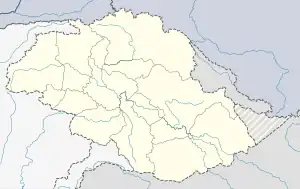 Hunza Valley/Hunza Dish 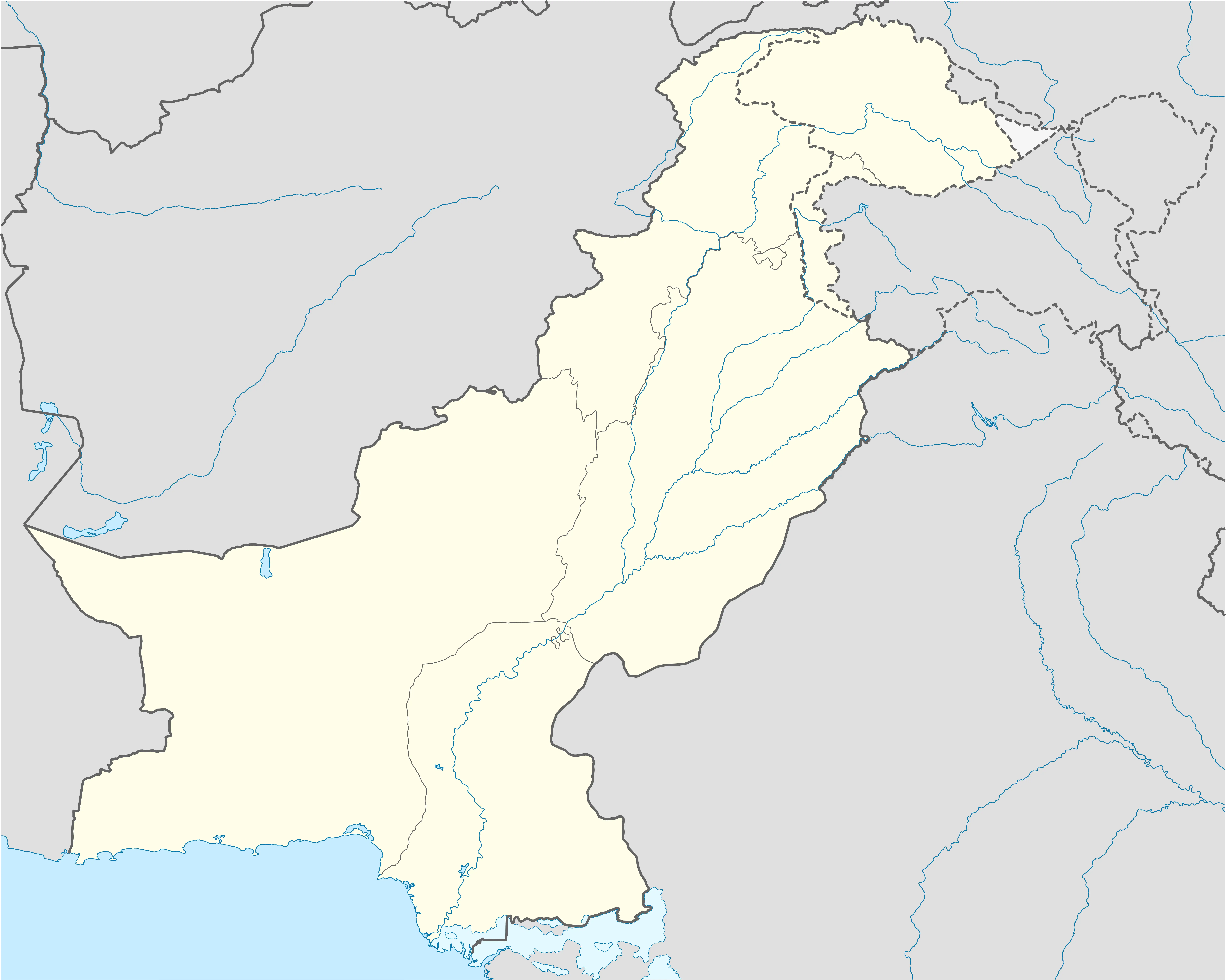 Hunza Valley/Hunza Dish | |
| Area | 11,660 km2 (4,500 sq mi) |
| Naming | |
| Native name | ہُنزا دِش (Burushaski) |
| English translation | Hunza Desh |
| Geography | |
| Country | Pakistan |
| State/Province | Gilgit-Baltistan |
| District | Hunza District |
| Population center | Hunza |
| Coordinates | 36.316942°N 74.649900°E [1] |
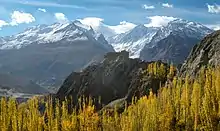
Geography
It takes shape alongside the Hunza River. The valley shares its borders with Ishkoman to the northwest, Shigar to the southeast, Afghanistan's Wakhan Corridor to the north, and the Xinjiang region of China to the northeast.[2] The Hunza Valley floor is at an elevation of 2,438 meters (7,999 feet). Geographically, the Hunza Valley consists of three regions: Upper Hunza (Gojal), Central Hunza, and Lower Hunza (Shinaki).
History
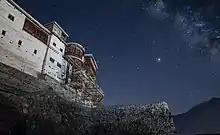


Buddhism and, to a lesser extent, Bön were the primary religions in the area. The region holds several surviving Buddhist archaeological sites, such as the Sacred Rock of Hunza. Hunza Valley was central in the network of trading routes connecting Central Asia to the subcontinent. It also provided protection to Buddhist missionaries and monks visiting the subcontinent, and the region played a significant role in the transmission of Buddhism throughout Asia.[3]
Before the arrival of Islam, the majority of the region practiced Buddhism. Since then, most of the population has converted to Islam. Thus, the presence of Buddhism in this region has now been limited merely to archeological sites, as the remaining Buddhists of this region moved east to Leh, where Buddhism is the majority religion. The region has many works of graffiti in the ancient Brahmi script written on rocks, produced by Buddhist monks as a form of worship and culture.[4] With most locals converting to Islam, they had been mainly left ignored, destroyed, or forgotten, but are now being restored.[5]
"Hunza was formerly a princely state bordering Xinjiang (autonomous region of China) to the northeast and Pamir to the northwest, which survived until 1974, when it was finally dissolved by Zulfikar Ali Bhutto. The state bordered the Gilgit Agency to the south and the former princely state of Nagar to the east. The state capital was the town of Baltit (also known as Karimabad); another old settlement is Ganish Village which means 'Baba Ganesh village' (a Buddhist name).[6] Hunza was an independent principality for more than 900 years and then in the early 1800s, Hunza played a vital role in the British "Great Game". In 1891 Hunza was captured by the British Empire, and the ruler of Hunza, Mir Safdar Ali Khan, fled to Kashgar, China, and the British army installed his brother Mir Nazim Khan (1892-1938) as a puppet ruler of Hunza Valley, but all orders were passed by British officers who were appointed in the capital Gilgit."[7]
Mir/Tham

According to an account written by John Biddulph in his book Tribes of the Hindoo Koosh:
The ruling family of Hunza is called Ayesha "aya-sha" (heavenly). The two states of Hunza and Nagar were formerly one, ruled by a branch of the Shahreis, the ruling family of Gilgit, whose seat of government was Nagar. First [M]uslim came to Hunza-Nagar Valley some 1000 years (At the time of Imam Islām Shāh 30th Imam Ismaili Muslims). After the introduction of Islam to Gilgit, married a daughter of Trakhan of Gilgit, who bore him twin sons, named Moghlot and Girkis. From the former, the present ruling family of Nager is descended. The twins are said to have shown hostility to one another from birth. Thereupon their father, unable to settle the question of succession, divided his state between them, giving Girkis the north/west, and to Moghlot the south/east bank of the river.[8]
2010 landslide
On 4 January 2010, a landslide blocked the river and created Attabad Lake (also called Shishket Lake), resulting in 20 deaths and 8 injuries and effectively blocked about 26 kilometres (16 mi) of the Karakoram Highway.[9][10][11][12] The new lake extends 30 kilometres (19 mi) and rose to a depth of 400 feet (120 m) when it was formed as the Hunza River backed up.[13] The landslide completely covered sections of the Karakoram Highway.[10][13]
Tourism



Hunza is a popular tourist destination due to its location and climate.[14] Several high peaks rise above 7,000 m in the surroundings of Hunza Valley. The valley provides views of several mountains, including:
Rakaposhi 7,788 m (25,551 ft), Ultar Sar 7,388 m (24,239 ft), Bojahagur Duanasir II 7,329 m (24,045 ft), Diran peak (7,266), Spantik (7027m), Ghenta Peak 7,090 m (15,631 ft), Hunza Peak 6,270 m (20,571 ft), Darmyani Peak 6,090 m (19,980 ft), and Bublimating (Ladyfinger Peak) 6,000 m (19,685 ft).
Many 7,000 m mountains are present in Hunza like Distaghil Sar, Batura, Batura II, Batura III, Muchu Chhish, Kunyang Chhish, Shispare, Passu Sar, Kanjut Sar, Yukshin Gardan Sar, Pumari Chhish, Momhil Sar and many more.
The fairy-tale-like castle of Baltit, above Karimabad, is a Hunza landmark built about 800 years ago. Stilted on massive legs, its wooden bay windows look out over the valley. Originally, it was used as the residence of the Mirs (the title of the former rulers) of Hunza. [2]
Hunza Valley is also hosting the ancient watchtowers in Ganish, Baltit Fort, and Altit Fort. Watchtowers are located in the heart of Ganish Village. Baltit Fort stands on top of Karimabad, whereas Altit Fort lies at the bottom of the valley. In the 8th century AD, a huge Buddha figure surrounded by small Buddhisatvas was discovered carved on a rock. Pre-historic men and animal figures are carved on rocks along the valley. Some lakes like Attabad Lake, Borith Lake, Shimshal Lakes, Hassanabad Lake are located in Hunza.
Khunjerab Pass is a 4,693-meter-high mountain pass in the Karakoram Mountains. It is in a strategic position on the northern border of Pakistan and on the southwest border of China and is also located in Hunza.
Eco-friendly hiking treks like Ondra Poygah Gulmit and Leopard Trek Shiskhat are also known for their views.[15]
The valley is popularly believed to be the inspiration for the mythical valley of Shangri-La in James Hilton's 1933 novel, Lost Horizon.[16]
One can witness the 57 km long Batura Glacier, the fifth-longest glacier in the world outside the polar region, surrounded by Shispare, Batura, and Kumpirdior peaks. Upon reaching Sost, one can continue the journey up to Khunzhrav or turn west to the Chipursan (also Chapursan) Valley. In Yarzerech (also Yarzirich), one can look at the Kundahill peak (6,000 m), or trek along the Rishepzhurav to the Kundahill. Beyond Yarzerech, one can travel further to Lupghar, Raminj, Reshit, Yishkuk up to Bobo Ghundi (Oston), the shrine of Baba-e-Ghund, a saint from Afghanistan near the border between Pakistan and the Wakhan region of Afghanistan.
2018 rescue mission
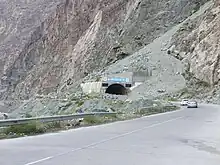
On 1 July 2018, Pakistan Army pilots rescued 3 foreign mountaineers stuck in a snow avalanche at above the height of 19,000 feet (5,800 m) on Ultar Sar Peak near Hunza. The weather conditions had made it difficult for the Army helicopter to go forth with a rescue operation on the 7,388 metres (24,239 ft) high Ultar Sar. Nonetheless, they completed it. Bruce Normand and Timothy Miller from the UK were successfully rescued alive while their companion Christian Huber from Austria had succumbed to the avalanche.[17][18] Britain's High Commissioner Thomas Drew in Pakistan termed the mission "remarkable and dangerous".[19][20]
People

The local languages spoken include Burushaski, Wakhi and Shina. The literacy rate of the Hunza valley is more than 95%.[21] The historical area of Hunza and present northern Pakistan has had, over the centuries, mass migrations, conflicts and resettling of tribes and ethnicities, of which the Shina people are the most prominent in regional history. People of the region have recounted their historical traditions down the generations. The Hunza Valley is also home to some Wakhi, who migrated there from northeastern Afghanistan beginning in the nineteenth century onwards.[22]
The longevity of Hunza people has been noted by some,[23] but others refute this as a longevity myth promoted by the lack of birth records.[24] There is no evidence that Hunza life expectancy is significantly above the average of poor, isolated regions of Pakistan. Claims of health and long life were almost always based solely on the statements by the local mir (king). An author who had significant and sustained contact with Burusho people, John Clark, reported that they were overall unhealthy.[25]
However, whether or not their putative longevity is true, it is undoubtable that the Hunza people lead a healthy lifestyle. Many researchers have lived with the Hunza people to answer this mystery including Robert McCarrison who did not discover a single person with diseases such as cancer, stomach ulcers or appendicitis.[26] Furthermore, Henri Coanda spent six decades studying the glacial water in Hunza and discovered possible explanations for the longevity of the Hunza people.[27]
See also
References
- "Rakaposhi Nagar on Google Maps". Google Maps. Retrieved 27 June 2018.
- "Mountainous Valley situated in the northern part of India". dreamstime.com. Archived from the original on 28 July 2018. Retrieved 3 June 2018.
- Behrendt, Kurt (2003). The Buddhist Architecture of Gandhāra. BRILL. p. 25. ISBN 978-90-474-1257-1.
- Susan E. Alcock; John Bodel; Richard J. A. Talbert (15 May 2012). Highways, Byways, and Road Systems in the Pre-Modern World. John Wiley & Sons. pp. 21–. ISBN 978-0-470-67425-3.
- Zara Khan, Vandalized Buddhist inscriptions in Gilgit-Baltistan are now being restored, Mashable Pakistan, 28 May 2020.
- History of Hunza, archived from the original on 22 December 2021, retrieved 2 October 2021
- Valley, Hunza. "Hunza Valley". skardu.pk. Archived from the original on 11 November 2016. Retrieved 23 November 2016.
- Tribes of the Hindoo Koosh by John Biddulph page 26
- Waheed, Abdul (4 January 2013). "The Attabad Landslide Disaster". Pamir Times. Archived from the original on 12 October 2019. Retrieved 12 October 2019.
- Ahmed, Kamran (23 May 2010). "Pakistan: The water bomb". ReliefWeb. Dawn. Retrieved 27 August 2022.
- "Annual Report 2011". Yumpu. National Disaster Management Authority, Government of Pakistan. pp. 40–41. Retrieved 27 August 2022.
- "SHISHKET LAKE CRISES – 2010 – CHRONOLOGY OF EVENTS" (PDF). ndma.gov.pk. NDMA. 27 July 2010. Retrieved 12 October 2019.
- Michael Bopp; Judie Bopp (May 2013). "Needed: a second green revolution in Hunza" (PDF). HiMaT. p. 4. Archived (PDF) from the original on 27 November 2015. Retrieved 26 November 2015. Karakorum Area Development Organization (KADO), Aliabad
- "Hunza Valley Travel Guide (Everything You Need To Know)". 29 May 2019. Retrieved 2 April 2023.
- admin (12 July 2021). "Amazing Views of Hunza Valley…". Trip Venture. Retrieved 19 April 2022.
- Curtis, James R. (1 September 1992). "Shangri-La and Pakistan's Hunza River Valley". Journal of Cultural Geography. 13 (1): 55–67. doi:10.1080/08873639209478400. ISSN 0887-3631.
- "Pakistan Army Pilots rescued 3 foreign mountaineers". en.dailypakistan.com.pk. July 2018. Archived from the original on 7 July 2018. Retrieved 7 July 2018.
- "Mountainers News on Thenews.com.pk". thenews.com.pk. Archived from the original on 7 July 2018. Retrieved 7 July 2018.
- Farmer, Ben (July 2018). "Britain's High Commissioner in Pakistan admired Pak Army Pilots for rescued the two British Climbers". The Telegraph. London. Archived from the original on 12 July 2018. Retrieved 8 July 2018.
- "Major General Asif Ghafoor also tweeted about it". forces.net. 2 July 2018. Archived from the original on 12 July 2018. Retrieved 12 July 2018.
- Siddiqui, Shahid. "Hunza disaster and schools". Dawn. Pakistan. Retrieved 6 July 2012.
- Frembgen Wasim, Jurgen (2017). The Arts and Crafts of the Hunza Valley in Pakistan: Living traditions in the Karakoram. Karachi: Oxford University Press. p. 1. ISBN 978-0-19-940520-6.
- Wrench, Guy T., Dr. (2009) [1938]. The Wheel of Health: A study of the Hunza people and the keys to health (reprint ed.). Review Press. ISBN 978-0-9802976-6-9. Retrieved 12 August 2010.
{{cite book}}: CS1 maint: multiple names: authors list (link) - Tierney, John (29 September 1996). "The optimists are right". The New York Times.
- Clark, John. "Hunza – the truth, myths, and lies about the health and diet of the "long-lived" people of Hunza, Pakistan – Hunza bread and pie recipes". biblelife.org. Archived from the original on 9 August 2018. Retrieved 31 July 2018.
- "Hunza people". Zee News. 23 April 2021. Retrieved 19 April 2022.
- "Hunza water, the fountain of youth". テクノス株式会社 (hisui-technos.com). Retrieved 19 April 2022.
ケイ素ミネラル水の秘水及び非加熱・無菌充填ミネラルウォータープラントのエンジニアリングサイト
Engineering site for secret water of silicon mineral water and non-heated / sterile filled mineral water plant
Further reading
- Kreutzmann, Hermann, Karakoram in Transition: Culture, Development, and Ecology in the Hunza Valley, Oxford University Press, 2006. ISBN 978-0-19-547210-3
- Leitner, G. W. (1893): Dardistan in 1866, 1886 and 1893: Being An Account of the History, Religions, Customs, Legends, Fables and Songs of Gilgit, Chilas, Kandia (Gabrial) Yasin, Chitral, Hunza, Nagar and other parts of the Hindukush, as also a supplement to the second edition of The Hunza and Nagar Handbook. And An Epitome of Part III of the author's "The Languages and Races of Dardistan". First Reprint 1978. Manjusri Publishing House, New Delhi.
- Lorimer, Lt. Col. D.L.R. Folk Tales of Hunza. 1st edition 1935, Oslo. Three volumes. Vol. II, republished by the Institute of Folk Heritage, Islamabad. 1981.
- Sidkey, M. H. "Shamans and Mountain Spirits in Hunza." Asian Folklore Studies, Vol. 53, No. 1 (1994), pp. 67–96.
- History of Ancient Era Hunza State By Haji Qudratullah Beg English Translation By Lt Col (Rtd) Saadullah Beg, TI(M)
- Wrench, Dr Guy T (1938), The Wheel of Health: A Study of the Hunza People and the Keys to Health, 2009 reprint, Review Press, ISBN 978-0-9802976-6-9, retrieved 12 August 2010
- Miller, Katherine, 'Schooling Virtue: Education for 'Spiritual Development' in Megan Adamson Sijapati and Jessica Vantine Birkenholtz, eds., Religion and Modernity in the Himalaya (London: Routledge, 2016).